Lab
PeARL is located in suites 1445A and 1445F at ECU’s College of Allied Health Sciences
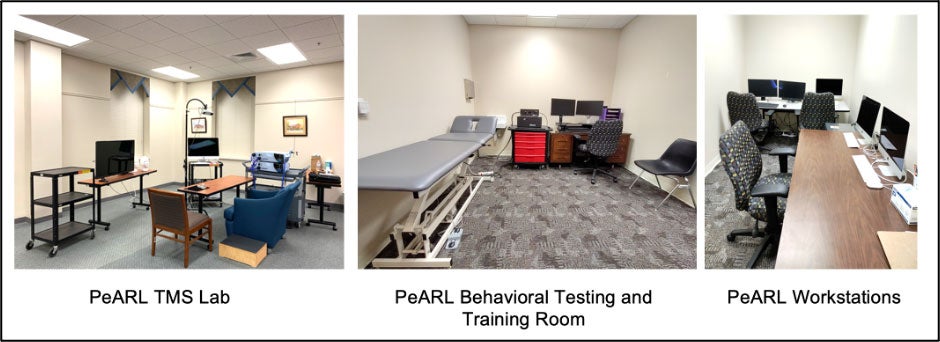
PeARL Equipment
Transcranial Magnetic Stimulator and Brainsight Neuronavigation System
The PeARL is equipped with a Magstim 2002 stimulator (Magstim Company Limited, Dyfed, UK). The Magstim 200 is a compact, high-power system capable of both cortical and peripheral stimulation. The stimulator has applications in various domains such as cortical mapping, and functional assessment of central motor pathways. The TMS has a 70 mm figure-of-eight shaped, 40 mm, and cone shaped stimulation coils. The stimulator can be controlled from the coil handset (D70 Remote, 90mm Remote), so the user doesn’t need to remove their hand to adjust the settings. The TMS is also coupled with a Brainsight neuronavigation system, which allows accurate placement of the TMS coil. The neuronavigation system allows the user to map a target for stimulation on an anatomical image and to position a coil with high accuracy (within 3mm), which ensures consistency of results. Any movement of the target during the treatment can be monitored in real time and the coil placement can be altered.
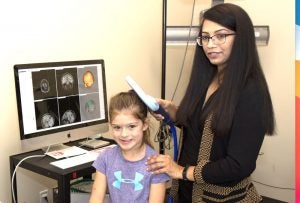
Transcranial Magnetic Stimulation (TMS)
Rapid Inflation Cuff
The PeARL is equipped with The Hokanson E20 Rapid Cuff Inflator. The Hokanson E20 Rapid Cuff Inflator and AG101 Cuff Inflator Air Source (D.E. Hokanson, Inc., Bellevue, WA) instruments are ideal for inflation of large or small blood pressure cuffs to a preset pressure. One use of the cuff inflator is for remote ischemic conditioning performed on a limb, in which the pressure can be adjusted to induce ischemia. The cuffs may be placed around the arm or thigh. Large bore solenoid valves control the inflation and deflation, making rate of air flow only limited by the size of the connective tubing to the cuff. The unit features a pressure readout display, which indicates the setting of the regulator and the pressure which will be applied to the cuff once it is inflated. A front panel mode switch is pressed to rapidly inflate or deflate the cuff. The pressure of the cuff may be further adjusted by turning the knob on the unit. The device can inflate a large thigh cuff to 50 mmHg pressure in less than 0.3 seconds and deflate it in less than 0.2 seconds.
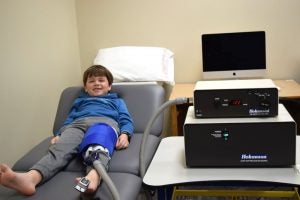
Rapid Cuff Inflator application on the thigh
Dynamic Stability Platform
The PeARL uses a dynamic stability platform (Lafayette Instrument, model 16030L, Lafayette, IN) for balance testing and training purposes. The stability platform has fully integrated timing functions for test control and electronic angle measurement for accuracy.
The PsymLab Psychomotor Control Software (Lafayette Instrument, Lafayette, IN) helps in organizing the participant information, designing/building customized experiments, and generating unique data reports.
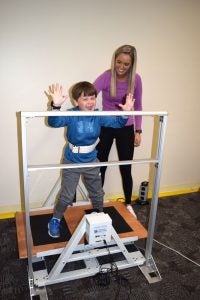
Dynamic Stability Platform
Total Gym RS Encompass Power Tower
The PeARL uses total gym for lower extremity strength and power training. An adjustable glide board of the RS encompass power tower provides versatility for high-performance power training.
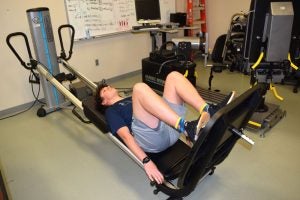
Total Body Gym
Wearable Technology: Accelerometers
ActiGraph GT9X Link accelerometers and Modus Health Stepwatches are used in the PeARL to obtain real-world activities data of the upper and lower extremities, respectively.
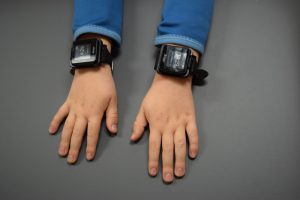
Wrist worn accelerometers
Behavioral Assessments
The PeARL uses various behavioral assessments to evaluate hand function.
Collaborative Equipment from the HMAL and STAR labs
3-D Motion Analysis
Two 15-camera 3D motion analysis systems (Qualisys AB, Göteborg, Sweden) are located in the Human Motion Analysis Laboratory (HMAL). HMAL is also equipped with Qualisys Track Manager and Visual 3D software (C-Motion, Inc. Germantown, MD).
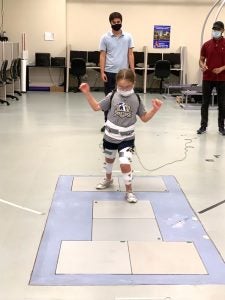
3-D Motion Analysis
HUMAC NORM Isokinetic Muscle Testing
Humac Norm isokinetic testing device is located in HMAL is used to assess muscle forces.
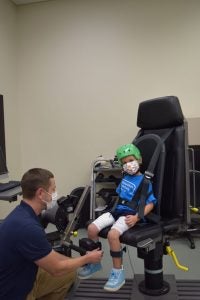
HUMAC NORM Isokinetic Muscle Testing
Functional Near Infrared Spectroscopy (fNIRS)
64-channel continuous wave fNIRS (NIRSport, NIRx, Germany) with a total of 16 sources and 16 detectors is located in the Sensorimotor Testing and Rehabilitation (STAR) lab. fNIRS, a non-invasive brain imaging techniques uses two different wavelengths of LED light (760 and 850 nm) to detect the changes of both oxy- (HbO) and deoxy-hemoglobin (Hb) in various brain regions of interest (ROI). The PeARL uses fNIRS to assess cortical activation during various motor and cognitive tasks and to assess the effects of interventions on cortical activation in children with cerebral palsy.
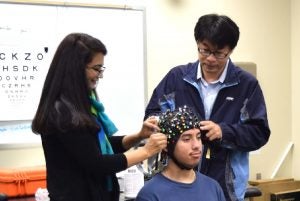
Functional Near Infrared Spectroscopy (fNIRS)
Other collaborative equipment
- Split Belt Treadmill
- Electromyography
- Sensory Organization Test
- GaitRite Gait Analysis
- Force Plates
- VisualEyes 515, interaucoustics (oculomotor assessment)
- Equitest, Neurocom, Natus (balance assessment)
- HTC VIVE Virtual Reality Headset
- GaitRite Portable Gait Analysis System
- Hur Balance Platform (portable)
- ReWalk Exoskeleton
- Metabolic Energy Expenditure Assessment Cart